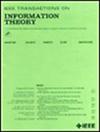稀疏信号重构:序列凸松弛、受限空属性和误差边界
IF 2.9
3区 计算机科学
Q3 COMPUTER SCIENCE, INFORMATION SYSTEMS
引用次数: 0
摘要
针对(近似)稀疏信号重建问题,我们提出了一种不精确的顺序凸松弛算法(iSCRA-TL1),它通过一种简单的自适应策略迭代构建工作索引集,并不精确地求解一系列截断的 $\ell _{1}$ -norm最小化子问题。我们提供了一个有趣的例子来证明 iSCRA-TL1 的精确版本可以成功地重建真正的稀疏信号,但目前几乎所有从 $\ell _{1}$ -norm 最小化最优解出发的序列凸松弛算法都无法恢复它。为了给 iSCRA-TL1 提供理论保证,我们引入了两种新的空空间性质,即受限空空间性质(RNSP)和顺序受限空空间性质(SRNSP),并证明它们都比普通的稳定空空间性质弱,而它们的鲁棒版本并不比现有的鲁棒空空间性质强。然后,我们证明了在合适的(鲁棒性)SRNSP下,iSCRA-TL1可以通过最多r个截断的$\ell _{1}$-norm最小化来识别真正的r-稀疏信号的支持或真正的近r-稀疏信号的前r个最大(以模为单位)项的索引集,其最终输出与真正的(近)r-稀疏信号的误差约束也被量化了。据我们所知,这是第一个在经典的 $\ell _{1}$ -norm 最小化问题缺乏良好鲁棒性的前提下,在较弱的 NSP 条件下,在特定步数内恢复真实(近)稀疏信号支持的连续凸松弛算法。本文章由计算机程序翻译,如有差异,请以英文原文为准。
Sparse Signal Reconstruction: Sequential Convex Relaxation, Restricted Null Space Property, and Error Bounds
For (nearly) sparse signal reconstruction problems, we propose an inexact sequential convex relaxation algorithm (iSCRA-TL1) by constructing the working index set iteratively with a simple and adaptive strategy, and solving inexactly a sequence of truncated
$\ell _{1}$
-norm minimization subproblems. A toy example is provided to demonstrate that the exact version of iSCRA-TL1 can successfully reconstruct the true sparse signal, but almost all the present sequential convex relaxation algorithms starting from an optimal solution of the
$\ell _{1}$
-norm minimization fail to recover it. To provide theoretical guarantees for iSCRA-TL1, we introduce two new types of null space properties, restricted null space property (RNSP) and sequential restricted null space property (SRNSP), and prove that they are both weaker than the common stable NSP, while their robust versions are not stronger than the existing robust NSP. Then, we justify that under a suitable (robust) SRNSP, iSCRA-TL1 can identify the support of the true r-sparse signal or the index set of the first r largest (in modulus) entries of the true nearly r-sparse signal via at most r truncated
$\ell _{1}$
-norm minimization, and the error bound of its final output from the true (nearly) r-sparse signal is also quantified. To the best of our knowledge, this is the first sequential convex relaxation algorithm to recover the support of the true (nearly) sparse signal under a weaker NSP condition within a specific number of steps, provided that the classical
$\ell _{1}$
-norm minimization problem lacks the good robustness.
求助全文
通过发布文献求助,成功后即可免费获取论文全文。
去求助
来源期刊

IEEE Transactions on Information Theory
工程技术-工程:电子与电气
CiteScore
5.70
自引率
20.00%
发文量
514
审稿时长
12 months
期刊介绍:
The IEEE Transactions on Information Theory is a journal that publishes theoretical and experimental papers concerned with the transmission, processing, and utilization of information. The boundaries of acceptable subject matter are intentionally not sharply delimited. Rather, it is hoped that as the focus of research activity changes, a flexible policy will permit this Transactions to follow suit. Current appropriate topics are best reflected by recent Tables of Contents; they are summarized in the titles of editorial areas that appear on the inside front cover.
 求助内容:
求助内容: 应助结果提醒方式:
应助结果提醒方式:


